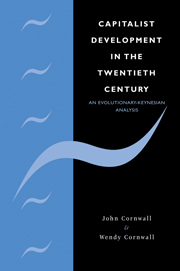Book contents
- Frontmatter
- Contents
- List of figures
- List of tables
- Foreword by David Colander
- Preface
- Part I Framework
- 1 Economic development and economic performance
- 2 The stylized facts
- 3 The neoclassical analysis of unemployment
- 4 An extended Keynesian model
- 5 Institutions and power
- 6 Evolutionary and hysteretic processes
- 7 Theories of capitalist development
- Part II Explaining the development record
- Part III Political control of the economy
- Bibliography
- Index
6 - Evolutionary and hysteretic processes
Published online by Cambridge University Press: 22 September 2009
- Frontmatter
- Contents
- List of figures
- List of tables
- Foreword by David Colander
- Preface
- Part I Framework
- 1 Economic development and economic performance
- 2 The stylized facts
- 3 The neoclassical analysis of unemployment
- 4 An extended Keynesian model
- 5 Institutions and power
- 6 Evolutionary and hysteretic processes
- 7 Theories of capitalist development
- Part II Explaining the development record
- Part III Political control of the economy
- Bibliography
- Index
Summary
Introduction
A central theme of this study is the role of changing economic structure in macroeconomic performance, specifically its role in generating alternating periods of good and poor macroeconomic performance. Beyond this, we examine the interaction between structure and performance which causes endogenous change in each, often by means of evolutionary processes. Chapter 6 brings together some of the main ideas of the previous three chapters to construct an evolutionary Keynesian framework for studying economic development. Before embarking on a detailed discussion of this framework, a brief review of the main points of the previous few chapters is helpful.
Chapters 2 and 3 discussed serious shortcomings of the supply-determined neoclassical equilibrium approach, including its inability to explain long-run outcomes within the model. Chapter 4 reversed the neoclassical direction of causation, and outlined a model of demand-determined dynamic processes. Chapter 4 also emphasized the unbalanced nature of economic growth, a ‘stylized fact’ completely overlooked by neoclassical and new growth analysis. Taking account of the changing composition of output emphasizes the changing allocation of factor resources as an inevitable accompaniment of economic growth. While recognizing that factors other than demand pressures affect macroeconomic performance, chapter 4 concentrated on demand as the primary endogenous force driving long-run performance. It did so by assuming a structural framework with no institutional constraints on aggregate demand and with substantially eased technology constraints. This led to an extension of the traditional Keynesian direction of causation.
- Type
- Chapter
- Information
- Capitalist Development in the Twentieth CenturyAn Evolutionary-Keynesian Analysis, pp. 94 - 111Publisher: Cambridge University PressPrint publication year: 2001

